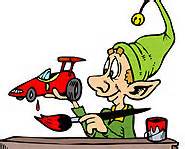Santa Claus and Elves
Elves have a long tradition in the oral and written traditions of many cultures across the planet. It has been only in relatively recent times that elves have been associated with Christmas.
In earlier times, elf was one name for a non-human creature that was thought to have special powers. Such creatures were also referred to as dwarves, gnomes, house spirits, forest spirits, and other names. Certain kinds of creatures dwelled in certain kinds of places, certain creatures had an affinity or an aversion to light, and certain creatures were more kindly disposed to humans. It was common practice for people to leave gifts for these creatures, in the hopes that such offerings would cut down on the mischief that the creatures regularly visited on people. Elves, in particular, were said to keep lists of people who had been nice to them (or not).
In Clement C. Moore's famous 1823 poem "A Visit from Saint Nicholas," Santa himself is described a "right jolly old elf." That poem mentions reindeer and stockings and other familiar elements of the Christmas tradition, but other elves are nowhere to be found.
 The first mention of more than one Christmas elf in American literature tradition is thought to be an unpublished 1850s work by Louisa May Alcott, who is most famous for writing Little Women and a number of sequels. The book was titled Christmas Elves.
The first mention of more than one Christmas elf in American literature tradition is thought to be an unpublished 1850s work by Louisa May Alcott, who is most famous for writing Little Women and a number of sequels. The book was titled Christmas Elves.
The idea of elves helping Santa in his workshop became more widespread with the idea of Santa's having a workshop, at the North Pole. A famous publication, Godey's Lady's Book, had on its cover in 1873 an illustration of Santa a number of elves, all in Santa's workshop. A book published a few years later had similar descriptions.
As the popularity of the secular Christmas story spread, so, too, did its images, with the elves morphing into the pointy-eared, tiny, toymakers that they are known as in many Western countries today.